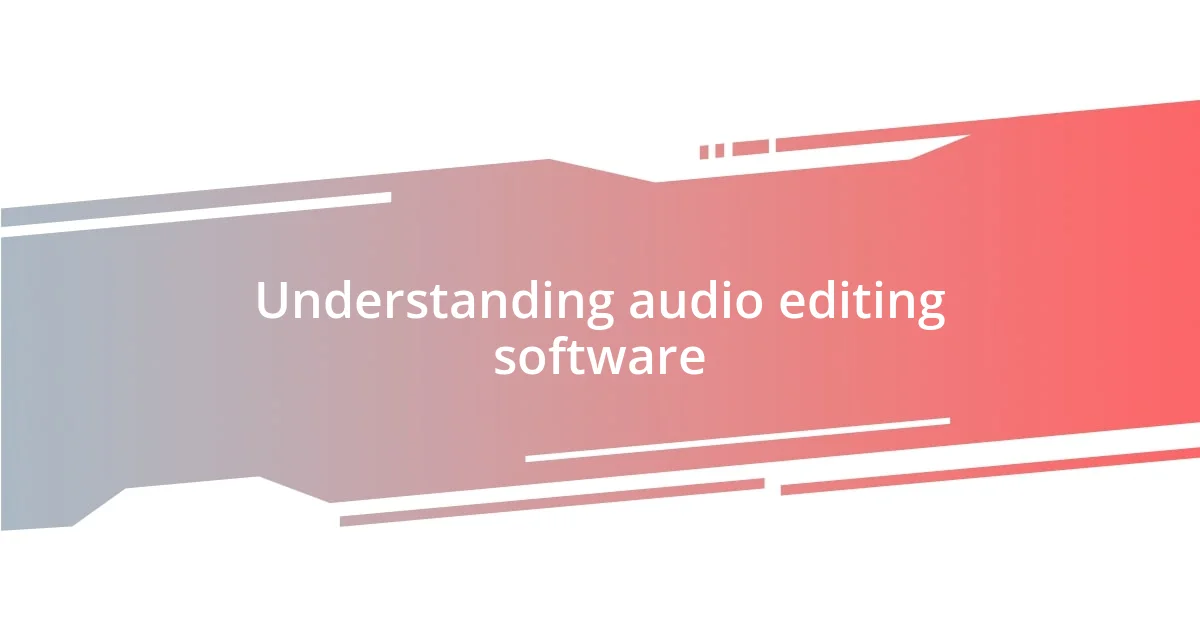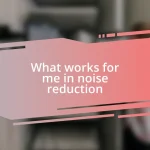Key takeaways:
- Mastering audio and using plugins can significantly enhance the quality and professionalism of audio projects.
- Consistent practice and seeking feedback are essential for developing audio editing skills and overcoming challenges.
- Finalizing audio projects requires taking breaks for fresh ears and optimizing sounds for various playback devices to ensure consistency.

Essential tools for audio editing
When I first started my audio editing journey, I quickly realized that having the right software is crucial. Audacity, for instance, was my go-to tool as a beginner. It’s free, accessible, and offers a wealth of features that helped me understand the basics of audio manipulation without overwhelming me. Have you ever found yourself grappling with a complex tool and wishing for something simpler? That’s how I felt until I learned to navigate Audacity’s interface, which ultimately built my confidence.
Then there are plugins—oh, how transformative they can be! I remember experimenting with VST plugins that enhanced my tracks’ sound quality in ways I hadn’t anticipated. The subtle reverb and compression made my recordings feel professional, and it felt like magic! I often wonder how many aspiring editors overlook this essential aspect. Plugins can truly elevate your audio projects, bringing them closer to the polished sound of industry professionals.
A reliable pair of headphones is another necessity I can’t stress enough. Initially, I used basic earbuds, which made it challenging to catch the nuances in my recordings. Then, I invested in a good quality set, and what a game changer that was! Who knew that the clarity of sound would drastically affect my editing decisions? This vital tool not only sharpened my skills but also deepened my appreciation for the intricacies of audio.

Understanding audio editing software
Understanding audio editing software can sometimes feel like diving into a vast ocean. My initial experience with various programs was both exciting and overwhelming. I vividly remember my first encounter with Adobe Audition; at first glance, its interface looked like a pilot’s cockpit with too many buttons! However, once I started exploring the spectrum of tools it offered, I found that it provided extensive capabilities for fine-tuning sound and enhancing audio quality. Transitioning from simpler software to more complex ones taught me that patience and practice are key.
What struck me about different audio editing platforms was their varying approaches to sound design. I’ll never forget my session with GarageBand; the ease of drag-and-drop functionality made the creative process feel fluid and intuitive. It was here that I composed my first piece, layering tracks and experimenting with loops. This experience opened my eyes to how engaging audio editing can be when the software aligns with your creative flow. Have you experienced a moment when a tool you were using suddenly made everything click? It’s those little breakthroughs that keep me coming back.
To truly appreciate audio editing software, one must understand its underlying features. Features like multi-track editing and audio effects are game-changers for anyone eager to improve their sound. I remember when I figured out how to use pitch correction; it dramatically changed my projects’ vocal quality. It’s the simple yet powerful features that can elevate your work and keep you motivated. Comparing different software side by side has become a valuable practice for me, highlighting each program’s strengths and weaknesses.
| Software | Price |
|---|---|
| Audacity | Free |
| Adobe Audition | Subscription-Based |
| GarageBand | Free (for Mac) |

Basic skills for audio editing
When diving into audio editing, I quickly learned that mastering some basic skills can significantly enhance my projects. Initially, I underestimated the importance of listening critically; it’s one thing to hear sound, and entirely different to analyze it. I recall the first time I listened to my own recordings with fresh ears—suddenly, I could identify background noise and inconsistencies that I’d previously overlooked. Engaging in active listening not only improved my editing decisions but also developed my overall sound sensitivity.
Here are a few essential skills for anyone starting their audio editing journey:
- Critical Listening: Develop the ability to identify issues in recordings, such as noise or imbalance.
- Basic Audio Theory: Understand concepts like frequency ranges and dynamic range to make informed edits.
- Timeline Familiarity: Get comfortable navigating the timeline in your software for smoother editing sessions.
Furthermore, I found that learning keyboard shortcuts was a game-changer for my efficiency. The first few times I edited without shortcuts felt painfully slow. But once I memorized the most common commands, my workflow transformed dramatically! I remember feeling a rush of excitement the first time I chopped an audio clip seamlessly—like I had unlocked a hidden level in a video game. Integrating these skills into my routine not only sped up my editing but made the process much more enjoyable.
- Keyboard Shortcuts: Familiarize yourself with shortcuts specific to your editing software to speed up your workflow.
- Basic Editing Techniques: Practice cutting, trimming, and fading audio effectively.
- Organizational Skills: Learn to label and organize your tracks for easy navigation during edits.

Advanced techniques for audio editing
One of the advanced techniques that transformed my audio editing skills was the art of mastering. At first, I thought mastering was just a final touch, but it’s much more than that. I had a moment of realization during one editing session; applying compression and equalization brought my tracks to life, tightening them into a coherent sound that felt polished and professional. Have you ever experienced that satisfying moment when everything just clicks? Mastering can turn a good mix into an exceptional one, creating a balanced sound that translates well across different playback systems.
Another technique I found invaluable is the use of bus processing. Learning to route various tracks through a single bus for group processing saved me both time and effort. I distinctly remember the first time I applied reverb to an entire drum kit; the depth it added to my mix was astounding. It felt like a light bulb went off in my head. By controlling the effects on a group instead of individual tracks, I was able to maintain a cohesive sound while fine-tuning the overall mix. Have you tried processing multiple tracks simultaneously? It’s a powerful way to streamline your workflow.
Finally, I can’t emphasize enough the importance of utilizing spectral editing. I had never heard of this technique until I stumbled across it in an online forum. When I first experimented with it, I was in awe of how it allowed me to visualize and target specific frequencies, cleaning up unwanted noise without losing the essence of the audio. The first time I cleaned up a vocal track with precision using spectral editing, I felt like a magician transforming a noisy recording into something beautiful. Have you explored this method of editing? It can truly elevate your audio projects to a professional level.

Tips for improving audio editing
When I began refining my audio editing skills, one tip that profoundly impacted my journey was implementing consistent practice. It’s tempting to jump into editing sessions sporadically, but I found that dedicating regular time to practice made a world of difference. I remember the moment I committed to an hour every day; suddenly, those technical skills that once felt foreign became second nature. Have you ever noticed how repetition can solidify concepts in your mind? By creating a routine, I accelerated my learning curve and could tackle more complex projects confidently.
Another crucial aspect I discovered was the power of feedback. Early on, I hesitated to share my work, fearing judgment, but inviting others into my editing process opened my eyes to new perspectives. One day, after letting a friend listen to a mix I thought was polished, their constructive criticism highlighted areas I hadn’t recognized. That experience taught me the value of collaboration in audio editing, pushing me to grow and refine my skills. Have you ever sought feedback from someone you trust? It can be an enlightening experience that fuels your improvement.
I also realized how important it is to stay updated with technology and trends in audio editing. I remember stumbling across a tutorial on a new plugin that promised to save time and enhance sound quality. My natural curiosity led me to explore it, and lo and behold, the outcome exceeded my expectations! The moment I integrated those modern tools into my workflow, I felt invigorated and inspired. Do you ever find yourself exploring new software or techniques? Embracing change can keep your editing process fresh and exciting while ensuring you stay at the forefront of the audio landscape.

Finalizing your audio projects
Finalizing your audio project is where the magic really happens. I remember the first time I sat down to export a track I had worked tirelessly on. The feeling was exhilarating but also nerve-wracking. I couldn’t help but ask myself, “Did I really capture what I envisioned?” Ensuring all elements blend seamlessly became my top priority during the finalization process.
One important step I learned is to take breaks before listening back to your finished mix. After investing hours into editing, I found that my ears needed a reset. I vividly recall taking a walk after a long session, letting my mind clear. When I returned and listened anew, I was able to pick up on subtle details I had initially overlooked. It’s astonishing how fresh ears can reveal areas that need tweaking. Have you tried stepping away before the final listen?
Another critical factor is optimizing the sound for the intended platform. I remember feeling thrown off balance when a track sounded perfect on my studio monitors but muffled when played through my phone. It hit me that different playback devices can drastically alter the listening experience. To prevent this, I started using headphones and various speaker setups for final checks. It’s all about ensuring that your work shines, no matter where it’s heard. What’s your method for testing audio across devices? It’s a game-changer!















